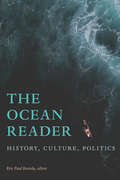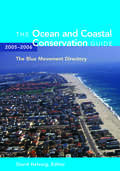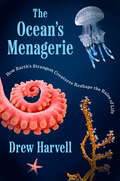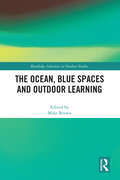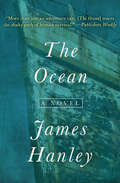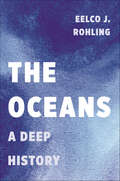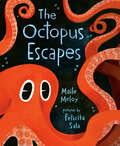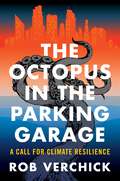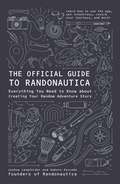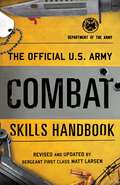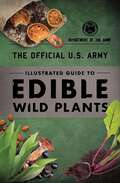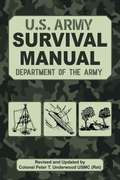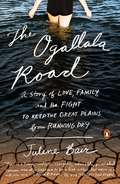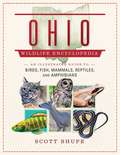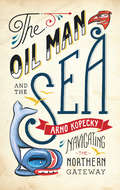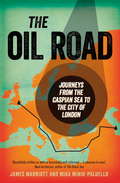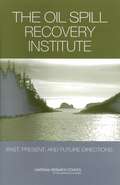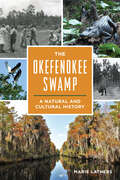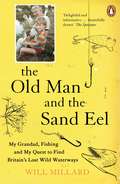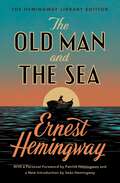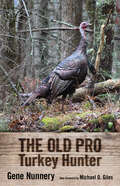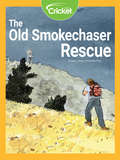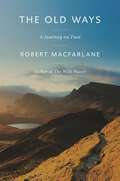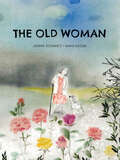- Table View
- List View
The Ocean Reader: History, Culture, Politics (The World Readers)
by Eric Paul RoordaFrom prehistoric times to the present, the Ocean has been used as a highway for trade, a source of food and resources, and a space for recreation and military conquest, as well as an inspiration for religion, culture, and the arts. The Ocean Reader charts humans' relationship to the Ocean, which has often been seen as a changeless space without a history. It collects familiar, forgotten, and previously unpublished texts from all corners of the world. Spanning antiquity to the present, the volume's selections cover myriad topics including the slave trade, explorers from China and the Middle East, shipwrecks and castaways, Caribbean and Somali pirates, battles and U-boats, narratives of the Ocean's origins, and the devastating effects of climate change. Containing gems of maritime writing ranging from myth, memoir, poetry, and scientific research to journalism, song lyrics, and scholarly writing, The Ocean Reader is the essential guide for all those wanting to understand the complex and long history of the Ocean that covers over 70 percent of the planet.
The Ocean Rescue (Octonauts Above & Beyond #3)
by Official OctonautsJoin Captain Barnacles, Kwazii and the Octonauts team in this exciting storybook adventure inspired by the Octonauts: Above and Beyond episode The Great Pacific Clean-Up! The Octonauts discover a massive patch of rubbish floating in the Pacific Ocean. With teamwork, quick-thinking and eco-friendly action, they launch a daring mission to clean up the sea and save the local creatures in need. Perfect for children aged 3-7, this illustrated story teaches kids about ocean pollution, recycling and how small actions can make a big difference for our planet. Packed with vibrant artwork from the TV series, favourite characters and a message of environmental care, this book is a must-have for fans of the Octonauts and young eco-heroes everywhere. Featuring interesting facts about the places and creatures that appear in the story. Whether it's bedtime reading or part of a classroom discussion about the environment, The Ocean Rescue blends fun, learning and adventure into one unforgettable story.
The Ocean and Coastal Conservation Guide 2005-2006: The Blue Movement Directory
by David HelvargA new environmental movement is emerging to help combat threats to America's oceans and coasts, with hundreds of local and regional groups as well as dozens of national and international organizations being formed. The Ocean and Coastal Conservation Guide represents a comprehensive guide to this new "Blue Movement." This one-of-a-kind new reference details more than 2,000 organizations and institutions that are working to understand, protect, and restore our ocean and coastal areas. For each entry, the book gives contact information including phone and fax numbers, email addresses, web addresses and a brief description of program areas of interest. Along with the state-by-state listings of groups, the directory includes three detailed sections that identify relevant government agencies, academic marine programs, and marine and coastal parks and protected areas. To be published biennially, The Ocean and Coastal Conservation Guide is a vital new resource for anyone interested in the growing community of people working to protect and restore our coastal lands and waters.
The Ocean's Menagerie: How Earth's Strangest Creatures Reshape the Rules of Life
by Drew HarvellAn elegantly written exploration of the cutting edge science of the strangest and most remarkable creatures on our planet by a leading marine biologistHundred-year-old giant clams, coral kingdoms that rival human cities, and jellyfish that glow in the dark: ocean invertebrates are among the oldest and most diverse organisms on earth, seeming to bend the &“rules&” of land-based biology. Although sometimes unseen in the deep, the spineless creatures contain 600 million years of adaptation to problems of disease, energy consumption, nutrition, and defense. In The Ocean&’s Menagerie, world-renowned marine ecologist Dr. Drew Harvell takes us diving from Hawaii to the Salish Sea, from St. Croix to Indonesia, to uncover the incredible underwater &“superpowers&” of spineless creatures: we meet corals many times stronger than steel or concrete, sponges who create potent chemical compounds to fight off disease, and sea stars that garden the coastlines, keeping all the other nearby species in balance. As our planet changes fast, the biomedical, engineering, and energy innovations of these wonderous creatures inspire ever more important solutions to our own survival. The Ocean&’s Menagerie is a tale of biological marvels, a story of a woman&’s passionate connection to an adventurous career in science, and a call to arms to protect the world&’s most ancient ecosystems.
The Ocean, Blue Spaces and Outdoor Learning (Routledge Advances in Outdoor Studies)
by Mike BrownThis book explores the educational dimension of people’s engagement with the ocean. Across formal, informal, and nonformal learning contexts, it examines how experiences of the ocean and ‘blue spaces’ help us to understand ourselves, others, and our place within the natural environment, and the place of the ocean in our sociocultural and political life. Drawing on creative projects from around the world, the book introduces topics as diverse as ocean sailing, migrants’ experiences of learning to surf, experiencing seascapes through sounds, and the importance of fostering connections with the sea. It provides examples of innovative teaching and learning practices, and the pedagogical possibilities that engagement with the ocean offers to outdoor studies scholars and practitioners in terms of education, and the enhancement of our well-being and the environment. This is fascinating reading for advanced students, researchers, teachers, and educational practitioners with an interest in outdoor studies, experiential and outdoor learning, leisure and recreation studies, environmental studies, or geography.
The Ocean: A Novel
by James HanleyFive shipwrecked passengers fight panic, thirst, and the sea itself One minute, sailor Joseph Curtain is in his bunk. The next, he is submerged in the ocean. A German torpedo has struck the Aurora, and she is sinking fast. Curtain makes his way to a lifeboat and guides the survivors aboard. There are only six of them, and when the submarine&’s machine gun rakes the side of their boat, the number dwindles to five. Alongside Curtain are three men of various character and an elderly chaplain who is too sick to speak. Hope is slim, but Curtain will do what he must to survive. He organizes the party into watches, rationing their food and enforcing strict discipline. But as their time in the boat stretches on, Curtain realizes that this tiny craft and its flagging crew are hardly a match for the power of the ocean.
The Oceans: A Deep History
by Eelco J. RohlingThe 4.4-billion-year history of the oceans and their role in Earth's climate systemIt has often been said that we know more about the moon than we do about our own oceans. In fact, we know a great deal more about the oceans than many people realize. Scientists know that our actions today are shaping the oceans and climate of tomorrow—and that if we continue to act recklessly, the consequences will be dire. In this timely and accessible book, Eelco Rohling traces the 4.4 billion-year history of Earth’s oceans while also shedding light on the critical role they play in our planet’s climate system.Beginning with the formation of primeval Earth and the earliest appearance of oceans, Rohling takes readers on a journey through prehistory to the present age, vividly describing the major events in the ocean’s evolution—from snowball and greenhouse Earth to the end-Permian mass extinction, the breakup of the Pangaea supercontinent, and the changing climate of today. Along the way, he explores the close interrelationships of the oceans, climate, solid Earth processes, and life, using the context of Earth and ocean history to provide perspective on humankind’s impacts on the health and habitability of our planet—and on what the future may hold for us.An invaluable introduction to the cutting-edge science of paleoceanography, The Oceans enables you to make your own informed opinions about the environmental challenges we face as a result of humanity’s unrelenting drive to exploit the world ocean and its vital resources.
The Octopus Escapes
by Maile MeloyFrom a New York Times bestselling author comes this poignant, lyrical tale about nature's great escape artist—perfect for fans of the Oscar-winning documentary film My Octopus Teacher.The octopus is happy in his undersea cave until one day, a diver captures him and takes him to live in an aquarium. The humans give him food and tests that look like toys. But every day is the same, and the octopus soon tires of captive life. And so, under the cover of darkness, he makes his daring escape...Maile Meloy and Felicita Sala bring us a story full of excitement and heart, about the thrill of hard-won freedom and the pull of home.
The Octopus in the Parking Garage: A Call for Climate Resilience
by Rob VerchickOne morning in Miami Beach, an unexpected guest showed up in a luxury condominium complex’s parking garage: an octopus. The image quickly went viral. But the octopus—and the combination of infrastructure quirks and climate impacts that left it stranded—is more than a funny meme. It’s a potent symbol of the disruptions that a changing climate has already brought to our doorsteps and the ways we will have to adjust.Rob Verchick examines how we can manage the risks that we can no longer avoid, laying out our options as we face climate breakdown. Although reducing carbon dioxide emissions is essential, we need to adapt to address the damage we have already caused. Verchick explores what resilience looks like on the ground, from early humans on the savannas to today’s shop owners and city planners. He takes the reader on a journey into the field: paddling through Louisiana’s bayous, hiking in one of the last refuges of Joshua trees in the Mojave Desert, and diving off Key Largo with citizen scientists working to restore coral reefs. The book emphasizes disadvantaged communities, which bear the brunt of environmental risk, arguing that building climate resilience is a necessary step toward justice.Engaging and accessible for nonexpert concerned citizens, The Octopus in the Parking Garage empowers readers to face the climate crisis and shows what we can do to adapt and thrive.
The Official Guide to Randonautica: Everything You Need to Know about Creating Your Random Adventure Story
by Joshua Lengfelder Auburn SalcedoBreak free from your usual routine and find adventure in your own neighborhood with this official field guide to the popular Randonautica app.Randonauts everywhere are exploring the world outside of their usual daily routes and expanding their previous understandings of the mind-matter connection. They are finding that once they arrive, there is often an eerily spot-on connection to the intention they set before generating the coordinates. Or they simply discover a place they haven&’t been before. In The Official Guide to Randonautica, the creators of the popular app explain how the intentions from the user translate to randomly generated coordinates, and all the theories about why users&’ set intentions can be so closely related to what they find at the given location. This book gives you the opportunity to log your experiences so you can make the most of what you discover on these journeys. Whether you&’re a new randonaut or a seasoned expert, this book is the perfect field guide for your next adventure.
The Official U.S. Army Combat Skills Handbook (U.S. Army)
by Department of the Army Matt LarsenModern combat is chaotic, intense, and shockingly destructive. A soldier will experience confusing and often terrifying sights, sounds, smells, and dangers—and he must learn to survive and win despite them. This field manual, containing the essential combat skills the U.S. Army teaches its soldiers, is the Army&’s most recent edition, which has been completely updated for Lyons Press by the soldier who wrote the manual for the army: Sergeant First Class Matt Larsen. Distributed to all soldiers, this is the must-have guide for those who want to know how U.S. Army soldiers are trained to prepare for--and perform during--combat. It includes photos, illustrations, and diagrams throughout depicting weaponry, combat maneuvers, warrior drills, survival techniques, fighting positions, camouflage, and basic field medicine.
The Official U.S. Army Illustrated Guide to Edible Wild Plants
by Department of the ArmyIn a situation where survival is at stake, plants can provide crucial food and medicine. Their safe usage requires absolutely positive identification, knowing how to prepare them for eating, and a solid awareness of any dangerous properties they might have. Familiarity with the botanical structures of plants and information on where they grow will make them easier to locate and identify.The Illustrated Guide to Wild Edible Plants describes the physical characteristics, habitat and distribution, and edible parts of wild plants. With color photography throughout, this guide facilitates the identification of these plants.Originally intended for Army use, this book serves as a survival aid for civilians as well. Anyone interested in the outdoors, botany, or even in unusual sources of nutrition will find this an indispensable resource.
The Official U.S. Army Survival Manual Updated (US Army Survival)
by Peter T. Underwood Department of the ArmyThis comprehensive new edition of U.S. Army Survival Manual, issued by the Department of the Army and thoroughly revised by Colonel Peter T. Underwood USMC (Ret), is ideal for military personnel and all outdoors enthusiasts. From the psychology of survival and basic medicine to personal camouflage and signaling techniques, this essential resource provides all the information you need to survive. Included here is a guide to identifying: • Poisonous snakes and lizards • Edible plants • Cloud formations as foretellers of weather • And more! With detailed photographs and illustrations and an extensive set of appendices, U.S. Army Survival Manual is your ultimate guide to survival in all conditions and environs.
The Ogallala Road: A Story of Love, Family, and the Fight to Keep the Great Plains from Running Dry
by Julene BairA love affair unfolds as crisis hits a family farm on the high plainsJulene Bair has inherited part of a farming empire and fallen in love with a rancher from Kansas's beautiful Smoky Valley. She means to create a family, provide her son with the father he longs for, and preserve the Bair farm for the next generation, honoring her own father's wish and commandment, "Hang on to your land!" But part of her legacy is a share of the ecological harm the Bair Farm has done: each growing season her family--like other irrigators--pumps over two hundred million gallons out of the Ogallala aquifer. The rapidly disappearing aquifer is the sole source of water on the vast western plains, and her family's role in its depletion haunts her. As traditional ways of life collide with industrial realities, Bair must dramatically change course.Updating the territory mapped by Jane Smiley, Pam Houston, and Terry Tempest Williams, and with elements of Cheryl Strayed's Wild, The Ogallala Road tells a tale of the West today and points us toward a new way to love both the land and one another.
The Ohio Wildlife Encyclopedia: An Illustrated Guide to Birds, Fish, Mammals, Reptiles, and Amphibians
by Scott ShupeOhio’s wildlife has always played an important role in the history of human beings inhabiting the state. Native Americans depended on birds, mammals, and fish for sustenance and the state’s first Europeans came in search of Beaver and buckskins. Although the state’s wildlife is still an important resource for human consumption, wildlife is also increasingly important in today’s culture for its intrinsic, aesthetic value. For many Ohioans, the age-old traditions of hunting and fishing have been replaced by a desire to simply observe wildlife and experience nature. But most Ohioans are largely unaware of the diversity of species inhabiting their state. This volume is intended to provide an introduction to the state’s fishes, amphibians, reptiles, birds, and mammals.In The Ohio Wildlife Encyclopedia, nationally known naturalist Scott Shupe has collected information on all the wildlife that reside in the Buckeye State. The first in a series of state wildlife encyclopedias, this book will be a handy, usable, layman’s guide to Ohio’s wildlife.Included are over 800 color photographs, depicting the different species of mammals, reptiles, amphibians, birds, and fish, while also offering over 600 range maps to show their territory. Along with basic information for the biology of each animal, Shupe includes the size, habitat, and abundance of each species located in the state.Whether you’re a lover of the outdoors, photography, or are looking to learn more about your state, this comprehensive guide will teach you about the wonderful wildlife that covers the water, earth, and skies of Ohio.
The Oil Man and the Sea: Navigating the Northern Gateway
by Arno KopeckyA sailing trip along the proposed Northern Gateway marine route with a fresh new voice in non-fiction.With oil and gas behemoth Enbridge Inc.'s Northern Gateway proposal nearing approval, supertankers loaded with two million barrels of oil may soon be plying the waters from northern British Columbia down the wild Pacific Coast. <P><P>This region is home to the largest tract of temperate rainforest on earth, First Nations who have lived there for millennia, and some of the world's most biodiverse waters-one spill is all it will take to erase ten thousand years of evolution.Arno Kopecky and his companions travel aboard a forty-one-foot sailboat exploring the pristine route-a profoundly volatile marine environment that registered 1,275 marine vessel incidents-mechanical failures, collisions, explosions, groundings, and sinkings-between 1999 and 2009 alone. Neither Kopecky nor the boat's owner have ever sailed before, yet they brave these waters alone when their captain leaves them part way through the journey.Written with Kopecky's quick humor and deft touch, this is a rich evocation of a mythic place and the ecology, culture, and history of a legendary region with a knife at its throat.
The Oil Road
by Mika Minio-Paluello James MarriottFrom Caspian drilling rigs and Caucasus mountain villages to Mediterranean fishing communities and European capitals, this is a journey through the heart of our oil-obsessed society. Blending travel writing and investigative journalism, it charts a history of violent confrontation between geopolitics, profit and humanity. From the revolutionary futurism of 1920s Baku to the unblinking capitalism of modern London, this book reveals the relentless drive to control fossil fuels. Harrowing, powerful and insightful, The Oil Road maps the true cost of oil.
The Oil Spill Recovery Institute: Past, Present, And Future Directions
by Committee to Review the Oil Spill Recovery Institute's Research ProgramAs a result of the 1989 Exxon Valdez Oil Spill in Prince William Sound, Congress passed the Oil Pollution Act of 1990 (OPA 90), and within that legislation, the Oil Spill Recovery Institute (OSRI) was born. This book assesses the strength and weaknesses of this research program, with empahsis on whether the activities supported to date address the OSRI mission, whether the processes used are sound, and whether the research and technology development projects are of high quality.
The Okefenokee Swamp: A Natural and Cultural History
by Marie LathersMarie Lathers wades into the history and legends of the Okefenokee Swamp. The Okefenokee, nearly 440,000 acres of bog and swamp lying in south Georgia and north Florida, is the largest blackwater wetland in North America. Almost all of these acres are protected by a National Wildlife Refuge, one of three access points to a land characterized by cypress, Spanish moss, and alligators. This book, with its broad overview of the Swamp and more detailed focus on certain aspects, has something for everyone, the nature-minded, history buffs, and regional culture enthusiasts. Read about the animals named for the Swamp--the Okefenokee fishing spider and zale moth--the history of lumbermen in the Swamp, the religious and musical practices of Swampers, and the novels and movies set in the Land of the Trembling Earth, including, of course, the infamous opossum, Pogo.
The Old Man and the Sand Eel
by Will Millard'A wonderfully fluent account of how the strange magic of water and the beings that inhabit it can enchant and intoxicate' Chris YatesGrowing up on the Cambridgeshire Fens, Will Millard never felt more at home than when he was out with his granddad on the riverbank, whiling away the day catching fish. As he grew older his competitive urge to catch more and bigger fish led him away from that natural connection between him, his grandfather and the rivers of his home. That is, until the fateful day he let a record-breaking sand eel slip through his fingers and he knew that he had lost the magic of those days down by the river, and that something had to change. The Old Man and the Sand Eel is at its heart the story of three generations of men trying to figure out what it is to be a man, a father and a fisherman. It plots Will's scaly stepping stones back to his childhood innocence, when anything was possible and the wild was everywhere.***'[Will Millard] is a master wordsmith and his first book is a joyful testament to that' Isabelle Broom, Heat'[Will Millard] writes with a genuine sense of humility (...) humour and reflection' Kevin Parr, Countryfile 'Delightful and informative (...) beautifully drawn (...)The Old Man and The Sand Eel will be enjoyed by anyone who loves the challenge and mystery of baiting a hook and plopping it into the water' Spectator'This is post-modern nature writing that embraces beauty where it finds it and marvels at nature's tenacity (...) But there's more here than just fish. This is also a book about growing up, about how to retain a connection with those who raised you while forging your own identity - what to keep and what to discard. And it's about men. The strong surges of emotion that both draw them together and keep them apart, and the shared pastimes which recognise that intimacy and meaning aren't always accompanied by words' Olivia Edward, Geographical
The Old Man and the Sea: The Hemingway Library Edition (Hemingway Library Edition)
by Ernest HemingwayErnest Hemingway&’s most beloved and popular novel ever, with millions of copies sold—now featuring early drafts and supplementary material as well as a personal foreword by the only living son of the author, Patrick Hemingway, and an introduction by the author&’s grandson Seán Hemingway.The last novel Ernest Hemingway saw published, The Old Man and the Sea has proved itself to be one of the enduring works of American fiction. It is the story of an old Cuban fisherman, down on his luck, and his supreme ordeal: a relentless, agonizing battle with a giant marlin far out in the Gulf Stream. Using the simple, powerful language of a fable, Hemingway takes the timeless themes of courage in the face of defeat and personal triumph won from loss and transforms them into a magnificent twentieth-century classic. Written in 1952, this hugely successful novel confirmed his power and presence in the literary world and played a large part in his winning the 1954 Nobel Prize for Literature.
The Old Pro Turkey Hunter
by Gene NunneryDuring his life, Gene Nunnery was recognized as a master turkey hunter and an artisan who crafted unique, almost irresistible turkey calls. In The Old Pro Turkey Hunter, the vaunted sportsman shares over fifty years of personal experience in Mississippi and surrounding states, along with the decades-old wisdom of the huntsmen who taught him. Throughout the book, his stories make clear that turkey hunting is more than just killing the bird—it is about matching wits with a wild and savvy adversary. As Nunnery explains, “To me that’s what it’s all about: finding a wise old gobbler who will test your skill as a turkey hunter.” Through his stories, Nunnery reveals that the true reward for successful turkey hunting lies in winning the contest, not necessarily exterminating the foe. Real sportsmen know that every now and then the turkey should and will elude the hunter. As Nunnery looks back on his extensive career, he analyzes vast differences in practice, old and new. The shift, he decides, came during his last twenty years on the hunt, and that difference has only increased in the decades since this book was originally published. Michael O. Giles, Bass Pro staff team member, master turkey hunter, and award-winning outdoors writer and author of Passion of the Wild, writes a new foreword that brings the practice of turkey hunting into the present day. Filled with a tested mixture of common sense and specific examples of how master turkey hunters honor their harvest and heritage, The Old Pro Turkey Hunter is the perfect companion for the novice or the adept.
The Old Smokechaser Rescue
by Diane L. BurnsKirk and his Granddad are out hiking in the mountains when Granddad injures his ankle. Since he can’t hike anymore, it’s up to Kirk to face the mountain and its unpredictable weather by himself to get back to the smokechasers’ tower and call for help.
The Old Ways
by Robert MacfarlaneFrom the acclaimed author of The Wild Places, an exploration of walking and thinkingIn this exquisitely written book, Robert Macfarlane sets off from his Cambridge, England, home to follow the ancient tracks, holloways, drove roads, and sea paths that crisscross both the British landscape and its waters and territories beyond. The result is an immersive, enthralling exploration of the ghosts and voices that haunt old paths, of the stories our tracks keep and tell, and of pilgrimage and ritual.Told in Macfarlane's distinctive voice, The Old Ways folds together natural history, cartography, geology, archaeology and literature. His walks take him from the chalk downs of England to the bird islands of the Scottish northwest, from Palestine to the sacred landscapes of Spain and the Himalayas. Along the way he crosses paths with walkers of many kinds--wanderers, pilgrims, guides, and artists. Above all this is a book about walking as a journey inward and the subtle ways we are shaped by the landscapes through which we move. Macfarlane discovers that paths offer not just a means of traversing space, but of feeling, knowing, and thinking.
The Old Woman
by Joanne SchwartzThe Old Woman is a beautiful portrait of an old woman who lives contentedly with her dog, from award-winning author Joanne Schwartz and illustrator Nahid Kazemi.An old woman shares her home with a scruffy old dog, her best friend and constant companion.One fall day, they go for a walk and the woman throws sticks for the dog. She loves hearing the autumn leaves under her feet and the wind in the trees. She looks up at a crow in the sky and imagines what it might feel like to fly. As the wind comes up and the light begins to fade, she remembers playing outside as a child, never wanting to go in. Suddenly she notices a stunning harvest moon against the darkening sky. The next morning, as she sits outside to watch the sun rise, she looks forward to spending a new day with her friend.Gentle illustrations accompany this portrayal of an elderly person who lives peaceably with her dog, appreciating what each moment brings.Correlates to the Common Core State Standards in English Language Arts:CCSS.ELA-LITERACY.RL.1.2>Retell stories, including key details, and demonstrate understanding of their central message or lesson.CCSS.ELA-LITERACY.RL.1.4Identify words and phrases in stories or poems that suggest feelings or appeal to the senses.CCSS.ELA-LITERACY.RL.3.7Explain how specific aspects of a text's illustrations contribute to what is conveyed by the words in a story (e.g., create mood, emphasize aspects of a character or setting)
